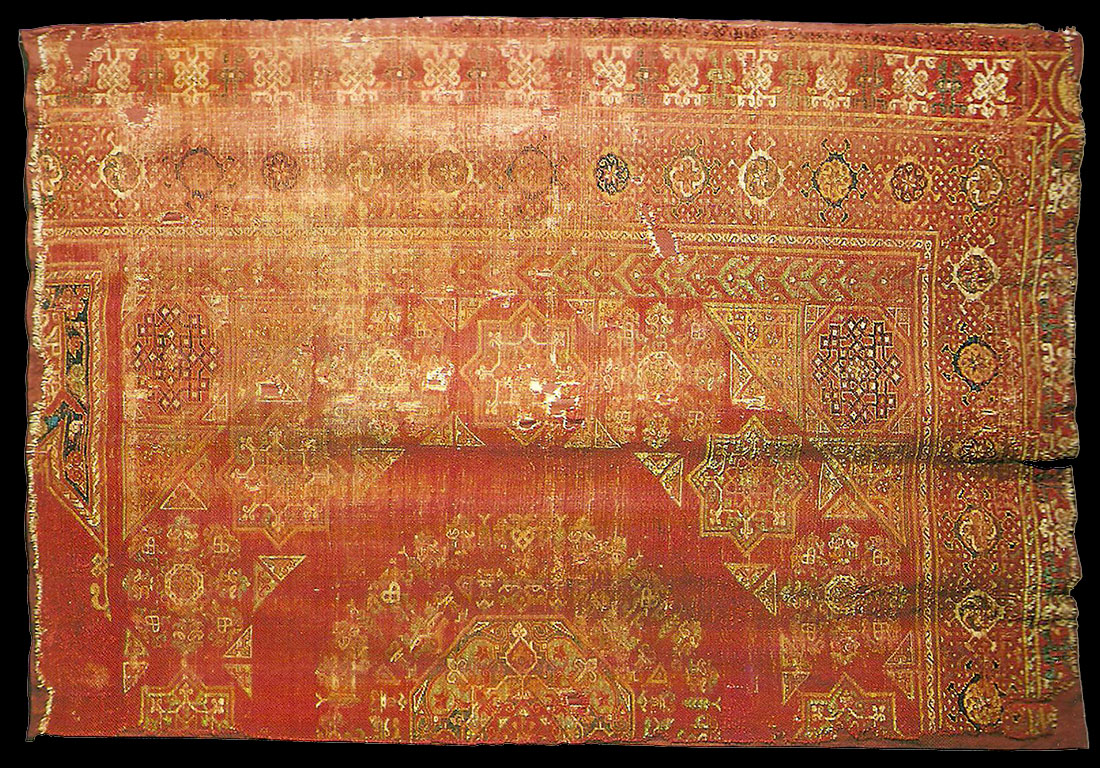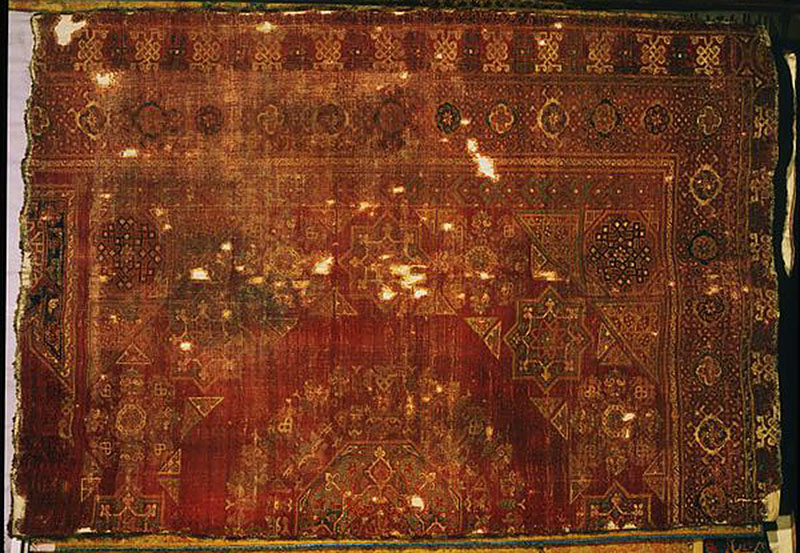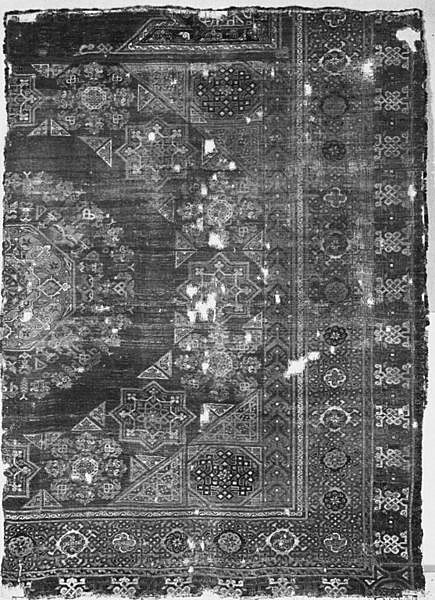back to "Historical Mamluk carpets
and rugs" main page
Sultan Qaitbay carpet
fragment, Victoria & Albert Museum, London
Place of origin: Cairo, Egypt (made)
Date: 1468-1496 (made)
Artist/Maker: unknown (production)
Materials and Techniques: Woven wool
Museum number: 150-1908
Gallery location: Islamic Middle East, room 42, case
20
Public access description: This is one of the very few
examples of Mamluk carpet-weaving that has survived from the reign of sultan
Qa段tbay. The Egyptian weavers
who made it drew on Iranian techniques and designs.
Qa段tbay was an outstanding example of a cultured Mamluk ruler who was brought
to Egypt as a slave. In 1435, when he was in his early twenties, he was
purchased by Sultan Barsbay and trained as one of his military attendants.
Because of his great ability, Qa段tbay rose to
become commander-in-chief, and in 1468 was acclaimed
sultan.
The reigns
of Mamluk sultans could be very short, but Qa段tbay ruled unchallenged for 28
years, dying in 1496. During this time, he earned a
reputation for piety. He founded and restored many
religious buildings and supplied them with minbars (mosque pulpits), lamps and
other
elegant
furnishings.
Keen
to stimulate economic activity, Qa段tbay encouraged the revival of skills such
as inlaid metalwork and the introduction of new industries,
including carpet-weaving.
Descriptive line
Fragment of a Mamluk carpet, Egypt (probably Cairo),
1468-96.
Physical
description
Size: 153x218cm.
Carpet
fragment, probably part of the lower left hand corner and half the width.
Analysed from the front because it is lined.
Warp: White wool; S5Z; 16-17 threads per inch (62 per
dm)
Weft: Red wool; S2Z;
3 shoots after each row of knots; 9-10 knots per inch (37-43 knots per dm)
Pile: Wool, 7 colours; red (lac, Mark Whiting, 1981),
yellow, dark green, green, dark blue, dark purple and white; assymetrical knot
open to the
left and
tied around 2 threads; 72-85 knots per sq. inch (1147-1333 knots per sq. dm)
Side Finish: Left: cut; Right: missing
End Finish: Lower: missing; Upper: cut
Design: Field: Red ground.
Right hand half of a medallion at the extreme left framed by minor medallions
but with evidence of a further such
frame at the very top. The medallion would have been
octagonal with a red lozenge centre with hooked devices extending into its dark
green
border; it
contains 2 green cartouches each with a white fleur-de-lys and a pair of red
flowers. The cartouches end in a curled leaf.
Beyond the medallion are two circles; the inner one
has yellow, green and white geometric motifs and the outer is more elaborate
with yellow
heart-shapes, horned and hooked, punctuated with inward facing slender green
trees.
The wide
band of the red ground would have been bordered as though it were an octagon by
a series of pairs of triangles (8 pairs survive).
Beyond them are 3 and 2 half
large stars outlined in green and then yellow, alternating with 4 small white
octagons surrounded by components
from the main medallion's outer circle, including the
heart-shapes and a group of 4 small botehs. The two existing outermost corners
of the
field each
contain a red octagon on which lies a convoluted knot design in dark purple; the
octagon is flanked by a pair of large green-outlined
triangles with an angular interlaced design in yellow.
The pair of triangles and octagons together create a corner triangle and
therefore part of
a
larger octagon.
Beyond the frame but in the field, to the right of this frame only, is a single
row of red and green upward pointing tracery, each unit extending
with a red or green neck and head into the lower part
of the next unit.
Above this section there is an apparent lower right hand corner of another field
area. The base line extends from the right hand borders
three-quarters of the way towards the centre and ends
in a knot and a hooked leaf.
Above is an angular indented border of reciprocal
white and yellow angular Z-motifs which form a zigzag to the left but form an
S-design on
the upper
right hand side. Within this border is a wider border with a dark blue ground
with a red knot in the right hand corner and stems with
'clouds'. There is evidence above this of a white
ground with small green angular motifs.
Borders: (Lower and right only)
Main Border: Ground of elaborated, extensive and tight
interlacing in red filled principally with white. On this is a series of
irregular octagons
with
4 pairs of horns in yellow, dark blue, white and green. Within lies a rosette
composed of a star overlaid by curved interlacing, sometimes
in 2 colours (like a Catherine wheel).
Outer Border: Red ground with brackets parallel to the
field joined by interlacing, in white alternating with a similar minor design in
dark green
and green.
Extreme bottom right shows evidence which suggests there was a particular corner
design in yellow. Lower outer border is
incomplete.
There are 3 important guard stripes:
1 / 2
1) Red ground with touching
white S-motifs alternating facing right and left
2) Reciprocal green/ red angular S-motifs as in border
of incomplete upper central motif
3) Reciprocal elaborate trefoil in red/dark purple
Museum number
150-1908
Object history note
Historical significance: This fragment is the oldest
known Mamluk carpet fragment and probably dates from the second half of the 15th
century. Its decoration dates from a period prior to
that of the classic Mamluk carpet and the motifs as well as the weaving
technique and red
dye
are typically Egyptian.
Exhibition History
Le ciel dans un tapis (L'Institut du Monde Arabe, Paris 08/12/2004-08/12/2004)
URL:
http://collections.vam.ac.uk/item/O108875/carpet-unknown/



